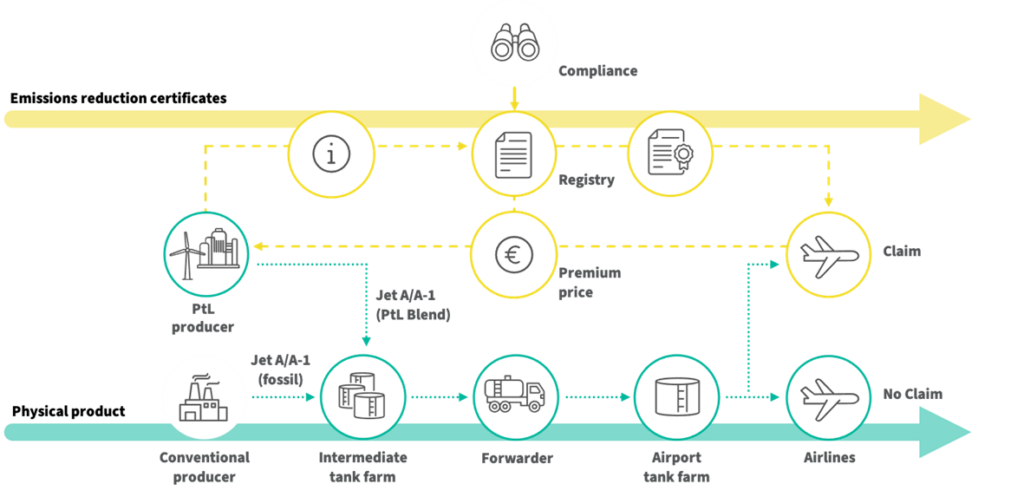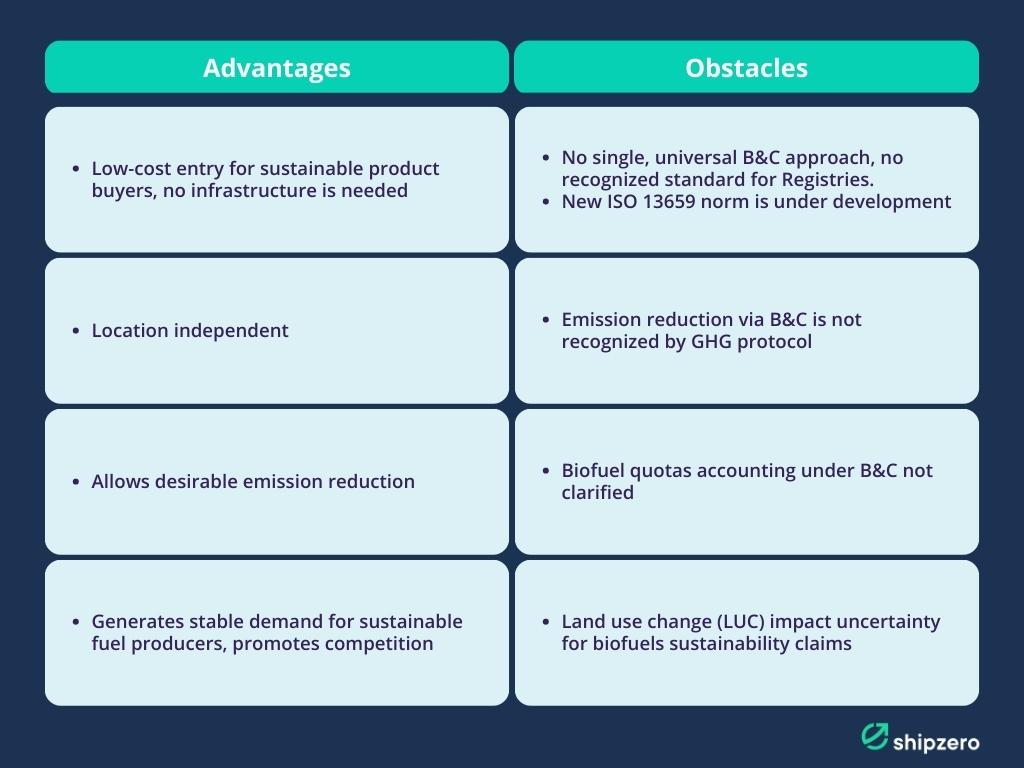The Book and Claim model (B&C) has become the ‘talk of the town’ in the offsetting and insetting debates. In this post, we shed light on this concept while exploring its recent developments, advantages, and obstacles for practical application.
Book and Claim: what is it about
B&C is one of the chain of custody [1] solutions to claim the sustainability of products used (i.e., sustainable fuels in the transportation industry). The key characteristic of the B&C model is that a company can make a sustainability claim without actually using sustainable products.
The most used example to explain the logic of B&C is a green electricity certificate. Consumers pay for electricity produced from renewable resources with lower emissions and could claim the amount of green energy purchased, and the emissions savings. However, they receive electricity from the common national grid where the green electricity cannot be physically traced.
The freight transportation sector, according to the ITF Transport Outlook 2021 report, is still projected to see a 22% rise in CO2 emissions by 2050 compared to 2015. Despite the technological advancements to reduce emissions in transportation, the widespread adoption of those is hindered by various industrial barriers. For instance, while sustainable fuels (SF) are readily available on the market, the demand is highly insufficient due to: high production and distribution costs, the significant investment required in low-emission vehicles (particularly in the maritime industry), geographical disconnection between fuel producers and consumers, and the complex nature of supply chain networks.
In the light of this challenge, the B&C model is viewed as a promising approach for reducing greenhouse gas emissions (GHG) in this sector. Pioneers in the development of the B&C model, including Smart Freight Center, Roundtable for Sustainable Biofuels and the World Economic Forum’s Clean Skies for Tomorrow initiative, see it as an effective means of addressing climate-related challenges in logistics and offsetting critics.
Under the B&C system, a specific quantity of sustainable fuel can be ´booked´ in one location and ´claimed´ at another location that is physically not linked to the original one. By paying a premium to sustainable fuel producers, a transport service provider can claim a reduction in its GHG emissions even though it does not have direct access to sustainable fuels and does not use them directly for its transportation activities.
Book and Claim: how does it work
Given that the aviation industry has advanced the most in applying the B&C model, we suggest looking at the sustainable aviation fuel (SAF) example of Book and Claim to explain how the system works.

The flow of B&C system can be shortly described in four main steps:
- SAF production. The sustainable fuel producer creates a certain amount of sustainable aviation fuel (SAF).
- SAF in the supply chain. Once SAF is purchased, it is blended with fossil kerosene at an intermediate tank farm. From that point is treated as conventional fuel and enters the supply chain to the airport, where it can be used by airlines or airports near the producer.
- Registry. The quantity and parameters of SAF produced are reported in the Registry. A Registry is an electronic data storage system that enables the registration, issuance, holding, transfer, and retirement of product units/certificates/credits. The SAF information from the producer is used to calculate the amount of GHG that will be avoided by using SAF.
- Emission reduction certificate. As soon as SAF is included in the Registry, it is ready to be traded. So, any airline willing to pay the premium price will be able to get the emission reduction certificates towards their accounting of CO2.
Advancements of book and claim in aviation and shipping industries
The World Maritime Forum B&C brief (March, 2023) highlights four main development streams for the B&C concept [2]: 1. frameworks for accounting and reporting; 2. demand aggregation projects; 3. B&C offers; 4. pilots to deploy B&C registries.
- Frameworks for accounting and reporting. Two frontrunners of the B&C topic, Smart Freight Center and Roundtable for Sustainable Biofuels, have published their B&C conceptualizations:
- Smart Freight Center (2021) guidelines describe principles for tracking aviation fuel environmental attributes, accounting GHG emission reduction benefits, and default emission factors for various SAF types.
- Roundtable for Sustainable Biofuels (2023) manual is focused on aviation and shipping sectors and specifies the B&C registry processes: registering, transferring, and retiring of the sustainability attributes.
- Demand aggregation projects. In aviation, the Sustainable Aviation Buyers Alliance (SABA) has demonstrated its solid backing of SAF by pooling resources for investment in SAF, and implementing B&C-based tracking systems. In shipping, such an example is Cargo Owners for Zero-Emission Vessels (coZEV), an initiative facilitated by the Aspen Institute, which is a cargo owner-led network to enable maritime freight customers to come together. Within its 2040 Ambition Statement, the Aspen Institute alongside Amazon, Patagonia, and Tchibo have co-founded the Zero-Emission Maritime Buyers Alliance (ZEMBA), which aims to accelerate commercial deployment of zero-emission shipping, enable economies of scale, and cargo owners collaborative potential.
- B&C offers. Fuel suppliers such as Sky NRG and Jet Aviation use the book and claim solutions to offer Sustainable Aviation Fuels to carriers. In the shipping industry, GoodShipping and Maersk have introduced similar services to their customers.
- Pilots for B&C registries involve the deployment of registries such as one developed by the RSB or by SABA. The RSB Registry is an electronic system that tracks the registration, issuance, transfer, and retirement of product units/certificates/credits. The unit of traceability is 1 ton of neat certified product (for ex, SAF). The registry allows two types of system users – producers/distributors and purchasers – with different certification requirements to open an account.
Book and claim: summarizing advantages and challenges
The aviation and shipping industries share similar benefits and obstacles in the widespread adoption of book and claim systems.
Advantages. The B&C system presents an attractive option for companies seeking to incorporate sustainable practices, as it offers an easy, low-cost entry with no infrastructural or transportation requirements, and is not restricted by location. For producers of sustainable fuels, it generates a reliable source of demand, thus promoting competition and lowering prices.
Obstacles. B&C could be suspected of greenwashing since companies claim sustainability without actually pursuing sustainable practices. At present, there are no universally accepted regulations governing Registries and the B&C model in general. This creates the risk of double counting and data manipulation. Another widely shared concern is that B&C emission reduction cannot be reported under either GHG Protocol or applied towards the achievement of an organization’s Science Based Targets Initiative (SBTi).
Thus, the next crucial steps in achieving low-emissions freight transportation may involve identifying methods for companies to collectively establish standard accounting frameworks, commercial norms, and a universally accepted approach to reporting standards, thereby driving convergence and acceptability of book and claim in this field.
—
[1] Chain of custody means a chronological physical or electronic proof of purchase, transport, control, transfer and /or use of a product or certain product properties (e.g., sustainability properties) (IPIECA, 2010)
[2] Advancements timeline till 2024 is provided here https://www.globalmaritimeforum.org/content/2023/03/GtZ-insight-brief_Book-and-claims_Figure-2.jpg
Sources:
- IPIECA, 2010. Chain of custody options for sustainable biofuels. https://www.ipieca.org/resources/chain-of-custody-options-for-sustainable-biofuels
- Green electricity certificate. https://en.wikipedia.org/wiki/Green_certificate
- ITF Transport Outlook 2021. https://www.oecd-ilibrary.org/transport/itf-transport-outlook-2021_e8125f08-en
- International PtX Hub, 2022. Book and Claim and the building of an international SAF market https://ptx-hub.org/webinar-approaches-book-and-claim/
- Global Maritime Forum, 2023. Accelerating Maritime Decarbonisation: A Book and Claim Chain of Custody System for the early transition to Zero-emission Fuels in Shipping. https://www.globalmaritimeforum.org/news/accelerating-maritime-decarbonisation-a-book-and-claim-chain-of-custody-system-for-the-early-transition-to-zero-emission-fuels-in-shipping
- Smart Freight Center, 2021. https://www.smartfreightcentre.org/en/news/public-comment-period-for-smart-freight-centre-framework-to-incentivize-freight-transportation-greenhouse-gas-emission-reduction-activities/82213/
- Smart Freight Centre and MIT Center for Transportation & Logistics, 2021. Sustainable Aviation Fuel Greenhouse Gas Emission Accounting and Insetting Guidelines.
- Roundtable for Sustainable Biofuels, 2023. RSB Book & Claim Manual (RSB Book & Claim Procedure). Version 3.0. https://rsb.org/wp-content/uploads/2023/04/RSB-PRO-20-001-001-RSB-Book-and-Claim-Manual-3.0.pdf
- World Economic Forum, 2020. Clean Skies for Tomorrow Sustainable Aviation Fuels as a Pathway to Net-Zero Aviation. https://www3.weforum.org/docs/WEF_Clean_Skies_Tomorrow_SAF_Analytics_2020.pdf
- ISO/AWI 13659. Chain of Custody — Book and Claim — requirements and guidelines. https://www.iso.org/standard/84426.html
- Cargo owners for zero emission fuels. https://www.cozev.org/
- Sustainable Aviation Buyers Alliance. https://www.flysaba.org/




